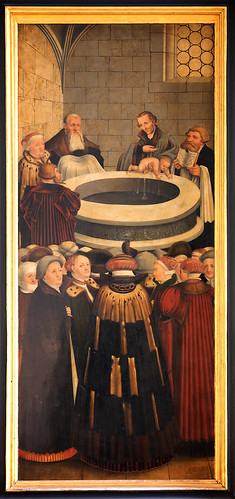A few years back I had the opportunity to live in Wittenberg for three months, and I visited this altar frequently. It is still there, and actually I was more excited to see this piece of art than I was to see the Melanchthon or Luther museums. I could stare at it for hours.
Steven Ozment has published an outstanding biography of Lucas Cranach that celebrates and contextualizes Cranach and his artistic ouevre. It's a slim and highly readable volume, with lots of reproductions of Cranach's art.
I won't offer a full review here (I feel ill-equipped to offer an extensive review of a piece of art criticism), but I do mention a few insights.
First, I learned that Cranach was famous for painting very attractive nudes. His approach was unique, even at times seductive, and it transformed the way painters of this era approached the nude. Interestingly, Ozment believes this is not unrelated to the Reformers embrace of married life and married clergy, and so his chapter on women and nudes, although at first blush seeming to be only about a painterly theme, is actually also profoundly theological.
I did not know how embedded Cranach was in Wittenberg as a tradesman and leader. His influence was substantial. I also did not understand fully how he was influenced by, but also moved away from, the deep influence Dürer was having on European art at that time. Ozment helped me see the difference.
 I had the sense that Cranach was very important in "marketing" Luther, but the chapter on this was still really helpful for understanding how Luther became the best-selling German author.
I had the sense that Cranach was very important in "marketing" Luther, but the chapter on this was still really helpful for understanding how Luther became the best-selling German author.
Finally, and perhaps the most intriguing part of the book from a theological perspective, is that Cranach was a hybrid Christian. He remained throughout his life committed both to Christian art and "secular" art, and he split the difference between Lutheran and Catholic, marketing art to both communities. Here is Ozment:
"Not only is the Weimar Altarpiece the "supreme visual monument of the German Reformation,' it is also the most incisive and succinct artistic expression of the Protestant gospel of faith alone. Therein, the viewer beholds an alternating, ecumenical Cranach, sometimes Protestant, sometimes Catholic. By all measures he was the best example the Protestants had of a 'mixed' Christian soul evidently at peace with itself." (278) Cranach as resource for visualizing ecumenism. Yes, quite.
And a friend pointed me to this new web resource for his art: http://www.lucascranach.org/aboutus_en.html



When were you there, Clint? I was in Halle for the whole summer of 2008 and visited Wittenberg three times.
ReplyDeleteFall of 2002. Great cities both.
ReplyDeleteThank you for sharing this magnificent visual Gospel with us. It depicts a dynamic evangelical life in the four Means of Grace: Baptism, Confession and Absolution, Communion, and Preaching Christ crucified. I use this with confirmands and in other catechesis. Your reflections are valuable.
ReplyDelete